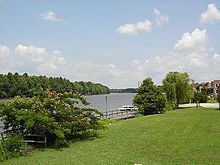Tidewater (region)

"Tidewater" is a term for the north Atlantic Plain region of the United States.
Definition
Culturally, the Tidewater region usually includes the low-lying plains of southeast
.The cultural Tidewater region got its name from the effects of the changing
Geography

The tidewater region developed when sea level rose after the last ice age, resulting in the flooding of river valleys in the coastal plain. Such flooded river valleys now make up the tidewater since tides continue to affect water levels far inland, in some cases all the way west to the
The term tidewater may be correctly applied to all portions of any area, including Virginia, where the water level is affected by the tides (more specifically, where the water level rises when the tide comes in). In the case of Virginia, the Tidewater region includes the land east of the
Tidewater is host to flora commonly associated with the South Atlantic pine forests and lower Southeast Coastal Plain maritime flora, the latter found primarily in southeastern Virginia.
Regional accents
A distinctive
See also
- Hampton Roads
- Inner Banks
- Southern Maryland
- Eastern Shore (Maryland)
- Eastern Shore (Virginia)
References
Notes
- ISBN 1-904275-17-6.
Geographically, Tidewater Virginia and Tidewater Maryland together form a triangle whose base extends from the Chesapeake Bay entrance westward through Hampton Roads and the lowlands south of the James River to Petersburg....
- ^ Dickinson, Joanne (August 5, 2015). "Along the Tidewater Region–I Can See Clearly Now…". Our Unbounded Heritage: 12th Century & Beyond. Retrieved January 20, 2021.
- ^ Fahrenthold, David (February 19, 2005). "Bay's Dialects Slowly Dying; As City Encroaches and Watermen Leave, Linguists Try to Preserve Vernacular". The Washington Post. Retrieved December 16, 2018.
- ^ Wernick, Adam (July 20, 2014). "An island in Chesapeake Bay is disappearing — and so is a British dialect and a piece of history". Public Radio International. Retrieved December 17, 2018.
- ^ "Title unknown". Archived from the original on July 26, 2009.
Bibliography
- Colin Woodard: American Nations: A History of the Eleven Rival Regional Cultures in North America. 2011. ISBN 978-0143122029
